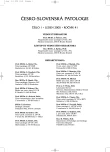Changes in Nitric Oxide Level in Striated Muscles of Rats Following Different Types of Death Running Title: Nitric Oxide Level in Striated Muscles after Death
Authors:
H. H. Pençe 1; S. Pençe 2; N. Kurtul 3; H. Kocuglu 4; E. Bakan 5; A. N. Kok 6
Authors‘ workplace:
MD, Ph D, Specialist in Gaziantep Children Hospital, Department of Biochemistry
Gaziantep, Turkey
1; MD, Ph D, MBA, Assistant Professor in Gaziantep University Medical School
Department of Physiology, Gaziantep, Turkey
2; Ph D, Assistant Professor in Sütçü Imam University Faculty of Science
Department of Chemistry, Kahramanmaras, Turkey
3; MD, Assistant Professor in Gaziantep University Medical School
Department of Anesthesiology and Reanimation, Gaziantep, Turkey
4; Ph D, Professor in Atatürk University Medical School, Department of Biochemistry
Erzurum, Turkey
5; MD, Professor in Atatürk University Medical School
Department of Forensic Medicine, Erzurum, Turkey
6
Published in:
Soud Lék., 50, 2005, No. 1, p. 2-6
Overview
Background:
Nitric oxide is a signal molecule regulating the organism functions in living bodies. The aim of this study was to investigate the NO levels of striated muscles after different types of death in rats.
Methods:
Nitric oxide levels in the muscles of masseter, triceps, and quadriceps obtained from right and left sides of 24 Spraque-Dawley rats following death were investigated. The rats were divided into three groups as cervical dislocation (control) group, electric shock group, and drowning group. After applying a light anesthesia, the rats were killed by cervical dislocation, electric shock and drowning. The samples were taken immediately and 120 minutes after death.
Results:
In all muscle types of all groups, NO concentrations were lower in samples obtained 120 minutes after death than in those obtained immediately after death. NO concentrations were lower in the electric shock and drowning group than in the control group for both times.
Conclusion:
We can conclude that the type of death may affect the occurrence of rigor mortis and NO measurement may give an important clue in evaluation the mode of death.
Key words:
nitric oxide – skeletal muscle – rat, electric shock – drowning
Labels
Anatomical pathology Forensic medical examiner ToxicologyArticle was published in
Forensic Medicine

2005 Issue 1
Most read in this issue
- Gamma-hydroxybutyrate (GHB) Misuse or Abuse and Interpretation of Toxicological Findings
- Changes in Nitric Oxide Level in Striated Muscles of Rats Following Different Types of Death Running Title: Nitric Oxide Level in Striated Muscles after Death
- New Legislation on Expert Witnesses in the Slovak Republic
